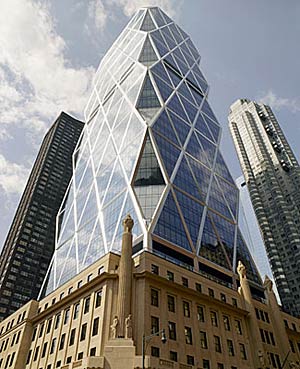With its partners DekaBank and the Deutsches Architekturmuseum, the City of Frankfurt am Main announced today that the Hearst Tower in New York by Foster and Partners is the winner of its 2008 International Highrise Award, given to a project completed between January of 2006 and April of 2008.

Chosen from among five finalists and 26 nominated projects by a seven-member jury that included Alejandro Zaero Polo of Foreign Office Architects (jury chair) and RECORD’s Suzanne Stephens, the Hearst Tower is the third building ever to receive the biennial prize of 50,000 euros and a sculpture by artist Thomas Demand. Created in 2003 by the City of Frankfurt, the International Highrise Award aims to encourage designers and developers to build skyscrapers (defined at a minimum height of 100 meters) “tailored to the requirements of tomorrow.” Its previous recipients are the Torre Agbar in Barcelona by Ateliers Jean Nouvel in 2006, and De Hoftoren in The Hague by Kohn Pedersen Fox Associates in 2004.
Rising out of an existing six-story Art Deco building designed in 1928 by Joseph Urban, the Hearst Tower has an unusual triangulated façade and zigzagging corners that render it a striking addition to the New York skyline. The building’s aesthetic is the result of its signature feature—a unique diagonal grid or “diagrid” structural system that reduces the building’s steel requirements by 20 percent. This technological innovation, along with a total building energy savings of 26 percent, led the jury to praise the Hearst Tower for its sustainability, writing that it “sets a new standard for office buildings in the metropolis of skyscrapers.”
According to Michaela Busenkell, curator at the Deutsches Architekturmuseum and coordinator of the 2008 award, the jury evaluated projects using drawings, photographs, and written descriptions (jury members do not make site visits because of lack of funds) and selected finalists and a winner according to an array of criteria. While relevant attributes included energy efficiency, cost-effectiveness, integration into the urban fabric, and “a special aesthetic,” Busenkell notes that the jury ultimately sought a building capable of serving as a model for future design. The Hearst Tower scored decisive points, she says, “because it is more than a refinement of an existing type; it is really a prototype.”
![]() In an exclusive RECORD reader poll earlier this week Newton Suites in Singapore by WOHA was voted the winner of the 2008 International Highrise Award. See a slide show of the finalists.
In an exclusive RECORD reader poll earlier this week Newton Suites in Singapore by WOHA was voted the winner of the 2008 International Highrise Award. See a slide show of the finalists.

Post a comment to this article
Report Abusive Comment